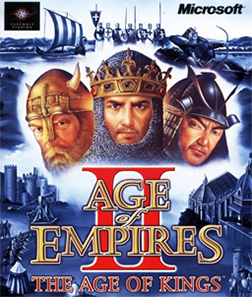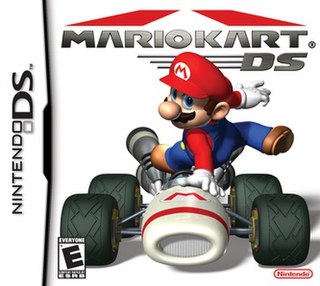
Age of Empires II: The Age of Kings is a real-time strategy video game developed by Ensemble Studios and published by Microsoft. Released in 1999 for Microsoft Windows and Macintosh in 2001, it is the second game in the Age of Empires series. The Age of Kings is set in the Middle Ages and contains thirteen playable civilizations. Players aim to gather resources, which they use to build towns, create armies, and defeat their enemies. There are five historically based campaigns, which conscript the player to specialized and story-backed conditions, as well as three additional single-player game modes; multiplayer is also supported.

Super Mario 64 DS is a 2004 platform game developed and published by Nintendo for the Nintendo DS. It was a launch game for the DS. Super Mario 64 DS is a remake of the 1996 Nintendo 64 game Super Mario 64, with new graphics, characters, collectibles, a multiplayer mode, and several extra minigames. As with the original, the plot centers on rescuing Princess Peach from Bowser. Unlike the original, Yoshi is the first playable character, with Mario, Luigi, and Wario being unlockable characters in early phases of the game.
The Wars series, also known as Famicom Wars and Advance Wars, is a series of military-themed turn-based strategy video games, predominantly developed by Intelligent Systems and published by Nintendo. The series debuted in Japan in August of 1988 with the original Famicom Wars, followed by sequels on the Super Famicom and Game Boy. These early installments were released in Japan, with Advance Wars (2001) being the first to reach the North American and European markets. Advance Wars was released in the United States on September 10, 2001, but put on hold in Japan and Europe due to the September 11 attacks. Although released in Europe in January 2002, neither Game Boy Advance game was released in Japan until the Game Boy Wars Advance 1+2 compilation, which released for the Game Boy Advance on November 25, 2004. The success of Advance Wars in the West is frequently credited as a driving force for Nintendo bringing Intelligent Systems' franchise Fire Emblem outside of Japan, as both series share a similar tactical gameplay style.

Mario Kart DS is a 2005 kart racing video game developed and published by Nintendo for the Nintendo DS handheld game console. It was released in November 2005 in North America, Europe, and Australia, and on December 8, 2005, in Japan. The game was re-released for the Wii U's Virtual Console in North America and PAL regions in April 2015 and in Japan in May 2016. The game is the fifth main entry in the Mario Kart series of video games, and the first to be playable via the Nintendo Wi-Fi Connection online service. Like other games in the series, Mario Kart DS features characters from the Mario series and pits them against each other as they race in karts on tracks based on locations in the Mario series.

Advance Wars: Dual Strike, known as Famicom Wars DS in Japan, is a turn-based strategy video game developed by Intelligent Systems and published by Nintendo for the Nintendo DS handheld game console. It is the third installment in the Advance Wars series and was released in 2005 for Japan on June 23, in North America on August 22, in Europe on September 30 and in Australia on March 22, 2006. The game is preceded by Advance Wars 2: Black Hole Rising and Advance Wars and succeeded by Advance Wars: Days of Ruin. Advance Wars is the international title of the Wars video game series, which dates back to the Family Computer game Famicom Wars in 1988.

Empires: Dawn of the Modern World is a 2003 real-time strategy video game developed by Stainless Steel Studios and published by Activision. Set in a world-historical period that extends from the Middle Ages to World War II, the game tasks players with guiding one of nine rival great civilizations to victory. Customer surveys from Stainless Steel's previous game, Empire Earth, were used as a starting point for Empires: these inspired the team to take a more minimalist design approach, and to include civilizations without overlapping styles of play. Empires was positively received by critics, who enjoyed its multiplayer component. However, certain reviewers disliked its single-player mode, and opinion clashed on the game's level of uniqueness compared to competitors such as Rise of Nations. The sales of Empires, when combined with those of Empire Earth, totaled 2.5 million units by 2004.

Age of Mythology (AoM) is a real-time strategy video game developed by Ensemble Studios and published by Microsoft Game Studios. It was released on October 31, 2002 in North America and on November 14, 2002 in Europe.

Empire Earth II is a real-time strategy video game developed by Mad Doc Software and published by Vivendi Universal Games and their subsidiary Sierra Entertainment on April 26, 2005. It is a sequel to Empire Earth, which was developed by the now-defunct Stainless Steel Studios. The game features 15 epochs, 14 different civilizations and has three playable campaigns: a Korean, German, and American one, as well as several other playable scenarios. The game received a positive reaction, earning a 79% average rating on GameRankings.

Rise and Fall: Civilizations at War is a real-time strategy video game developed by both Stainless Steel Studios and Midway Games which was released in June 2006. The game incorporates segments of both third-person and first-person shooter gameplay, by allowing the player to temporarily control a "hero". Rise and Fall is based in the first millennium BC, and features four playable civilizations: Persia, Greece, Egypt, and Rome. The game includes over eighty civilization-unique military units, as well as eight "hero" units—of which only one may be purchased during a game. In Rise and Fall, there are two campaigns: one follows the conquests of Alexander the Great; and the other, the fictional liberation of Egypt by Cleopatra.

Bionicle Heroes is a 2006 video game published by Eidos Interactive and TT Games Publishing and based on Lego's Bionicle line of constructible action figures. The game was released in November 2006 on PlayStation 2, Xbox 360, GameCube, Microsoft Windows, Game Boy Advance, and Nintendo DS; a Nintendo Wii version was later released in April 2007. The home console and PC versions were developed by Traveller's Tales, while Amaze Entertainment developed the handheld versions. A version of the game for mobile phones, developed by Universomo, was also released. The home console and PC versions of the game are third-person shooters, while the Game Boy Advance version is a run 'n' gun shoot 'em up and the Nintendo DS version is a first-person shooter. The story of Bionicle Heroes, where the player seeks to liberate the island of Voya Nui and its inhabitants from the villainous Piraka, is not canon to the official Bionicle story.

Heroes of Mana is a 2007 real-time strategy video game developed by Brownie Brown and Square Enix and published by Square Enix for the Nintendo DS. It is the ninth game of the Mana series and the fourth entry in the World of Mana subseries, following the release of Dawn of Mana three months prior. Set in a high fantasy universe, Heroes of Mana follows a young soldier, Roget, as he journeys to defend several nations from the ruthless aggression of his own country in a series of battles.

Panzer Tactics DS is a turn-based tactical video game for the Nintendo DS developed by Sproing Interactive Media. It was released in North America on November 7, 2007. An HD remake by bitComposer Games, named Panzer Tactics HD, was released for PC and iPad on May 22, 2014.
In personal computer games, a spawn installation is an installed copy of a game that may only be used to play in multiplayer mode, or otherwise limits the amount of single-player content accessible to the user. Additionally, some spawn implementations only allow the user to join games hosted by the installer's cd-key. There are several purposes for a spawn installation, including but not limited to creating added value by allowing the owner of the game to experience the multiplayer mode with friends and demonstrating the game to more potential buyers.

Sid Meier's Civilization Revolution is a 4X, turn-based strategy game developed in 2008 by Firaxis Games with Sid Meier as designer. It is a spin-off of the Civilization series. The video game was released for the PlayStation 3, Xbox 360, Nintendo DS, Windows Phone, and iOS. A Wii version was originally expected but was cancelled. The absence of a PlayStation Portable version was attributed to a lack of development manpower.

Advance Wars: Days of Ruin, released as Advance Wars: Dark Conflict in Europe and Australia, is a turn-based strategy video game for the Nintendo DS handheld game console. It is the fourth installment in the Advance Wars series after Advance Wars: Dual Strike and was released in 2008 for North America on January 21; in Europe on January 25; and in Australia on February 21. A Japanese release was planned under the title of Famicom Wars DS: Lost Light, but was canceled after a series of delays. It finally became available in Japan through Club Nintendo in October 2013 as a downloadable platinum status reward for the Nintendo 3DS family of systems.
Strategy is a major video game genre that emphasizes thinking and planning over direct instant action in order to achieve victory. Although many types of video games can contain strategic elements, as a genre, strategy games are most commonly defined as those with a primary focus on high-level strategy, logistics and resource management. They are also usually divided into two main sub-categories: turn-based and real-time, but there are also many strategy cross/sub-genres that feature additional elements such as tactics, diplomacy, economics and exploration.

Age of Empires: Mythologies is a turn-based strategy video game based on Age of Mythology. It is the sequel to Age of Empires: The Age of Kings for the Nintendo DS.

Guitar Hero: On Tour is a series of music video games based on the Guitar Hero series for the Nintendo DS handheld game system. The series is developed by Vicarious Visions and published by Activision. Three games in the series have been released since June 2008: Guitar Hero: On Tour, Guitar Hero On Tour: Decades, and Guitar Hero On Tour: Modern Hits.

Worms: Battle Islands is an artillery turn-based strategy developed by Team17 and part of the Worms series, released for the PlayStation Portable and Wii in 2010. Players take turns controlling teams of anthropomorphic worms and using whatever means at their disposal to destroy opposing teams and become the one with the last team surviving. Both versions of the game were released to mixed reviews.

Ancestors Legacy is a real-time strategy video game developed by Polish studio Destructive Creations and published by 1C Company. It was released on Microsoft Windows on May 22, 2018, Xbox One and PlayStation 4 on August 13, 2019, and Nintendo Switch on June 11, 2020.

















